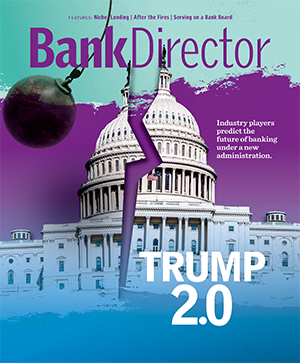As Director of Research at Janney Montgomery Scott, Chris Marinac oversees the firm’s Equity Research team, which covers more than 225 companies within the Financials, Healthcare, Infrastructure, and Real Estate sectors. The team aims to provide first class research on companies and the industry at large—which means staying ahead of the curve, understanding investors, and considering how events today will affect the future. Chris has more than 27 years of financial services and research analysis experience. Prior to joining Janney in 2019, he was Co-Founder and Director of Research at FIG Partners LLC, a premier investment banking and research firm specializing in community banks. At FIG, he established and managed an award-winning Equity Research team that covered more than 150 banks, thrifts, and REITs. Earlier in his career, he spent six years as Managing Director at SunTrust Robinson Humphrey and five years as a Research Analyst at Wachovia Corporation (formerly Interstate/Johnson Lane Inc.).

Debunking the Myth that Big Banks Dominate Deposit Share
The truth is that too-big-to-fail banks have barely moved deposit share in the past two years.
Brought to you by Janney Montgomery Scott LLC

In our view, investors continue to overlook the value of deposits despite three high-profile bank failures, and struggles by others, early last year. Yes, we remember the uncertainty over Federal Deposit Insurance Corp. coverage, especially with operating payroll accounts, and debate over the overall health of the banking system. As the experiences of 2023 linger, so does the misperception that the largest U.S. Banks or too-big-to-fail (TBTF) institutions gained market share and have now left the rest of the industry behind — this isn’t true.
Our research confirms that the TBTF banks had only a minuscule 50-basis-point gain in U.S. deposits between December 2022, when their share stood at 43.3%, to September 2024, when it totaled 43.8%, based on FDIC data. Our perspective is that franchise deposits, or what we define as the real core deposits that remain after brokered funding and government/municipal accounts, are excluded from total deposits using regulatory call report filings for all U.S. financial institutions.
Our calculations start in December 2019, before the pandemic, taking $14 trillion in total deposits in the FDIC system and subtracting $1 trillion in brokered CDs and $535 billion in government and municipal accounts. This results in $12.4 trillion in true franchise deposits among all FDIC charters nationwide. The TBTF banks comprised 43.7%, or $5.4 trillion in deposits, at year-end 2019. In comparison, as of Sept. 30, 2024, the entire U.S. system expanded deposits to $19.1 trillion, with franchise deposits (ex-brokered and government funds) totaling $17 trillion, or 37% growth over the past five years. The TBTF banks’ share as of September 2024 was 43.8% — a mere 10-basis-points change in market share since 2019. It is a hardly worth bragging about the fact that the largest U.S. banks have simply maintained market share.
Investor perception that big banks have dominated and significantly expanded market share since December 2022 is untrue and supported only by the minor change in the latest FDIC data. As we noted earlier, TBTF bank share had a minuscule uptick between late 2022, before the failure of Silicon Valley Bank, and the end of this year’s third quarter. While technically a gain in share, is it really that impressive to investors? While financial social media posts suggest significant changes to the largest TBTF banks, FDIC data suggests only a modest change. A half-point share gain does not qualify as significant.
It is true that franchise deposits slipped by about 3.5% in dollar terms over the past 21 months for all U.S. banks, as brokered and muni accounts rose incrementally. Brokered CDs and government funds increased slightly, though since December 2022 they have remained at modest levels of total funding for the U.S. financial system. Since 2019, true core, or franchise, deposits have been 37% greater, slightly exceeding the pace of total deposits. The growth over the past five years is impressive and often not well understood by investors of all sizes. This presents an opportunity to better educate and track how these franchise funds progress over the next two years. The U.S. deposit system saw an over 1.5% expansion in total deposits since the beginning of September, according to weekly Federal Reserve data. This leads us to be optimistic about deposit flows and franchise deposit value creation for the rest of this quarter and throughout 2025.
Going forward, bank stocks are putting the 2023 fears into their rearview mirror, while the road ahead is considerably brighter. We think the inherent premiums on core deposits can rise considerably more than stock prices and M&A valuations displayed in the past 18 months. Investors should value deposits based on the true core level, excluding brokered and municipal accounts. Further, the underlying cost of funds is far more important than the label on the deposit type. CDs, for instance, should not be shunned if they are appropriately priced to relationship customers. Likewise, money market accounts are welcome, and money market deposit account pricing absolutely impacts company value. When rates are high, the funding cost advantage relative to Fed Funds leads to core outflows and a lower multiple. This reduces a bank’s franchise value. Conversely, lower rates and better pricing leads to greater value on the franchise-based deposits. As a result, deposit-based valuations strengthen as investors pay a larger multiple for the spread between funding costs and Fed Funds. We think 2025 could be a period where franchise values will improve meaningfully.


